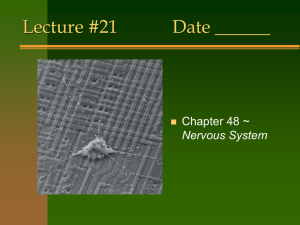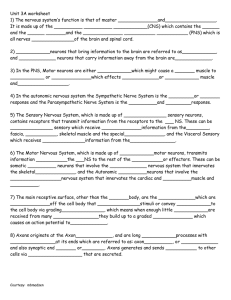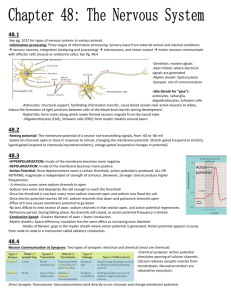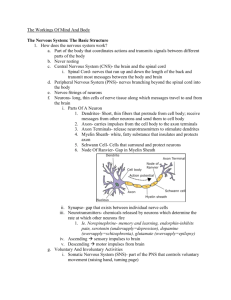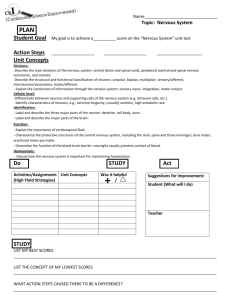48 Nervous
advertisement
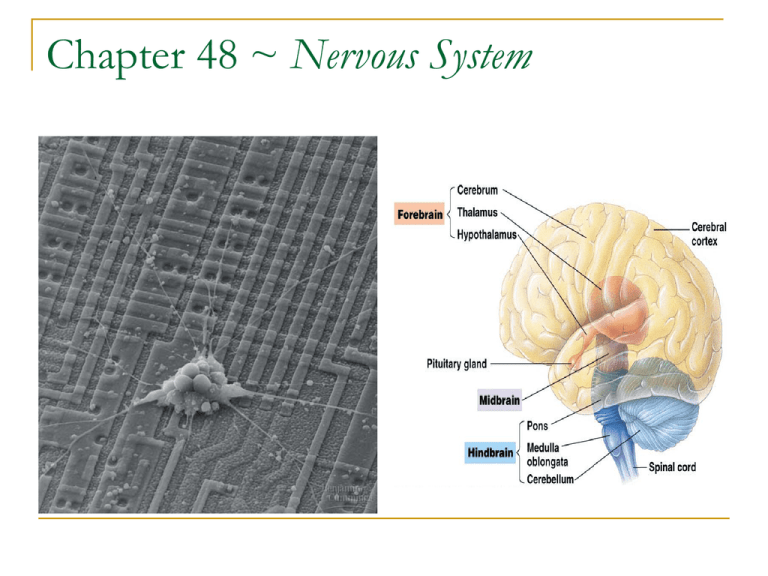
Chapter 48 ~ Nervous System The Nervous System http://outreach.mcb.harvard.edu/animations/synaptic.swf Neurons Glial cells Soma Axon Dendrite Synapse Neurotransmitters Action potential Motor neurons Interneurons Sensory neurons Myelin sheath Schwann cells Reflex arc Nervous systems Effector cells~ muscle or gland cells Nerves~ bundles of neurons wrapped in connective tissue Central nervous system (CNS)~ brain and spinal cord Peripheral nervous system (PNS)~ sensory and motor neurons Structural Unit of Nervous System Neuron~ structural and functional unit Cell body~ nucelus and organelles Dendrites~ impulses from tips to neuron Axons~ impulses toward tips Myelin sheath~ supporting, insulating layer Schwann cells~PNS support cells Synaptic terminals~ neurotransmitter releaser Synapse~ neuron junction Simple Nerve Circuit http://msjensen.cehd.umn.edu/1135/Links/Animations/Flash/0016-swf_reflex_arc.swf Sensory neuron: convey information to spinal cord Interneurons: information integration Motor neurons: convey signals to effector cell (muscle or gland) Reflex: simple response; sensory to motor neurons Ganglion (ganglia): cluster of nerve cell bodies in the PNS Supporting cells/glia: nonconductiong cell that provides support, insulation, and protection Neural signaling http://bcs.whfreeman.com/thelifewire/content/chp44/4403s.swf http://outreach.mcb.harvard.edu/animations/actionpotential.swf Membrane potential (voltage differences across the plasma membrane) Intracellular/extracellular ionic concentration difference K+ diffuses out (Na+ in); large anions cannot follow….selective permeability of the plasma membrane Net negative charge of about -70mV http://bcs.whfreeman.com/thelifewire/content/chp44/4402s.swf Neural signaling http://www.mind.ilstu.edu/curriculum/neurons_intro/flash_electrical.php?modGUI=232&compGUI=1827&itemGUI=3158 Excitable cells~ cells that can change membrane potentials (neurons, muscle) Resting potential~ the unexcited state of excitable cells Gated ion channels (open/close response to stimuli): photoreceptors; vibrations in air (sound receptors); chemical (neurotransmitters) & voltage (membrane potential changes) Neural signaling Graded Potentials (depend on strength of stimulus): 1- Hyperpolarization (outflow of K+); increase in electrical gradient; cell becomes more negative 2- Depolarization (inflow of Na+); reduction in electrical gradient; cell becomes less negative Neural signaling Threshold potential: if stimulus reaches a certain voltage (-50 to -55 mV)…. The action potential is triggered…. Voltage-gated ion channels (Na+; K+) 1-Resting state •both channels closed 2-Threshold •a stimulus opens some Na+ channels 3-Depolarization •action potential generated •Na+ channels open; cell becomes positive (K+ channels closed) 4-Repolarization •Na+ channels close, K+ channels open; K+ leaves •cell becomes negative 5-Undershoot •both gates close, but K+ channel is slow; resting state restored Refractory period~ insensitive to depolarization due to closing of Na+ gates Neural signaling “Travel” of the action potential is self-propagating Regeneration of “new” action potentials only after refractory period Forward direction only Action potential speed: 1-Axon diameter (larger = faster; 100m/sec) 2-Nodes of Ranvier (concentration of ion channels); saltatory conduction; 150m/sec Synaptic communication Presynaptic cell: transmitting cell Postsynaptic cell: receiving cell Synaptic cleft: separation gap Synaptic vesicles: neurotransmitter releasers Ca+ influx: caused by action potential; vesicles fuse with presynaptic membrane and release…. Neurotransmitter Signal transmission http://www.bayareapainmedical.com/neurtrns.html Neurotransmitters http://www.blackwellpublishing.com/matthews/neurotrans.html Acetylcholine (most common) •skeletal muscle Biogenic amines (derived from amino acids) •norepinephrine •dopamine •serotonin Amino acids Neuropeptides (short chains of amino acids) •endorphin Nervous System Central Nervous System Crainial Nerves Spinal Nerves Peripheral Nervous System Sensory (afferent) Division Sensing external environment Sensing internal environment Motor (Efferent) Division Autonomic Nervous System Sympathetic Nervous System Parasympathetic Nervous System increase energy consumption conservation of energy Somatic Nervous System voluntary, conscious control, muscles Vertebrate PNS The Brain Meninges Cerebrospinal fluid Ventricles Brain Stem Medulla oblongata Pons midbrain Diencephalon Thalamus Hypothalamus Cerebellum The Vertebrate Brain Forebrain •cerebrum~memory, learning, emotion •cerebral cortex~sensory and motor nerve cell bodies •corpus callosum~connects left (analytical) and right (creative) hemispheres •thalamus (main input/output from cerebrum); hypothalamus (hormone production) Midbrain •inferior (auditory) and superior (visual) colliculi Hindbrain •cerebellum~coordination of movement •medulla oblongata/ pons~autonomic, homeostatic functions Pituitary Gland Corpus Callosum Cerebrum Cerebral hemispheres Cerebral cortex—”gray matter” Convolutions Cerebral lobes Frontal lobe— conscious thought and muscle control. Parietal Lobes— receive information from skin receptors. Occipital Lobe— receives visual input. Temporal Lobe—has areas for hearing and smelling.
